Climbing Shoes: A Guide to Better Fit Your Next Pair
- Posted on
- By Branden Corliss
- Posted in Gear, Rock Climbing
- 0
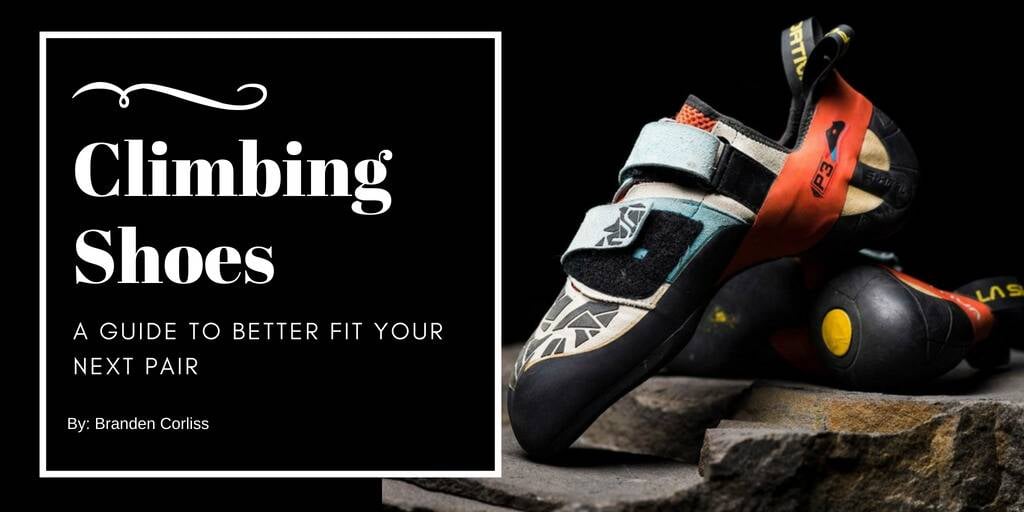
In this article, we'll give you a few key points to help you understand the different builds of a climbing shoe as well as their different purposes. [ Reading Time: 10 min ]
The perfect climbing shoe. Comfier than your old pair of sweatpants that your significant other is too embarrassed to let you wear in public, but built to send a new level of 5.16 climbing. Supple enough to walk up those blank friction slabs, but so wildly down turned you’ll be crawling up your next inverted cave proj’ like you’d been bitten by some sort of radioactive spider. Unfortunately, to my knowledge no such shoe exists just yet, though I'm sure the day it’s released you can be sure retailers are going to carry nothing else. In the meantime, however, we’re left with the much more difficult decision of trying to choose: “What shoe is best for me? Leather? Asymmetry? Last? Downturn? My buddy says solutions are the best, gimme’ those.” This is about as easy as answering who your soulmate is, but hopefully by explaining a few key shapes, designs and technologies I can make this choice slightly more informed than “I want an aggressive shoe...” only to find out your expensive new downturned shoes pair together with your favourite slab crag about as well as unicorn socks and sandals.
Shape: Profile and Asymmetry
We’ll start with profile, as well as last shape or “asymmetry” since these two characteristics, especially the profile, are what people most often associate with how “aggressive” a shoe is. More importantly, however, these are the characteristics that will dictate how comfy the shoe is, and how it will perform in different types of terrain.
Flat
As obvious as it sounds, these are shoes that allow your foot to lie in a flat position and are what a lot of people would call “beginner shoes”. These do make great starter shoes since they allow the foot to sit in a more natural (therefore comfortable) position, making them much more forgiving on a beginner's yet to be desensitized toes and will generally perform well as an all-arounder. However one of the biggest mistakes I see people make is classifying flat shoes as beginner shoes. Some of the hardest climbs out there have been sent in some of the most plain/flat shoes on the market (Tommy Caldwell on the Dawn Wall, Alex Honnold’s free solos, Chris Sharma on Dream Catcher and so on…). Flat shoes, such as Five Ten Mocassyms, or La Sportiva Mythos excel on slab terrain where the flat profile allows more contact with the rock when friction is the name of the game, but will also perform well as a vertical edging shoe. Due to the nature of these shoes, they will also allow you to slot into cracks nicely for toe/foot jams, and be much more bearable on multi-pitch climbs, where your foot will have plenty of time to get acquainted with your shoe.
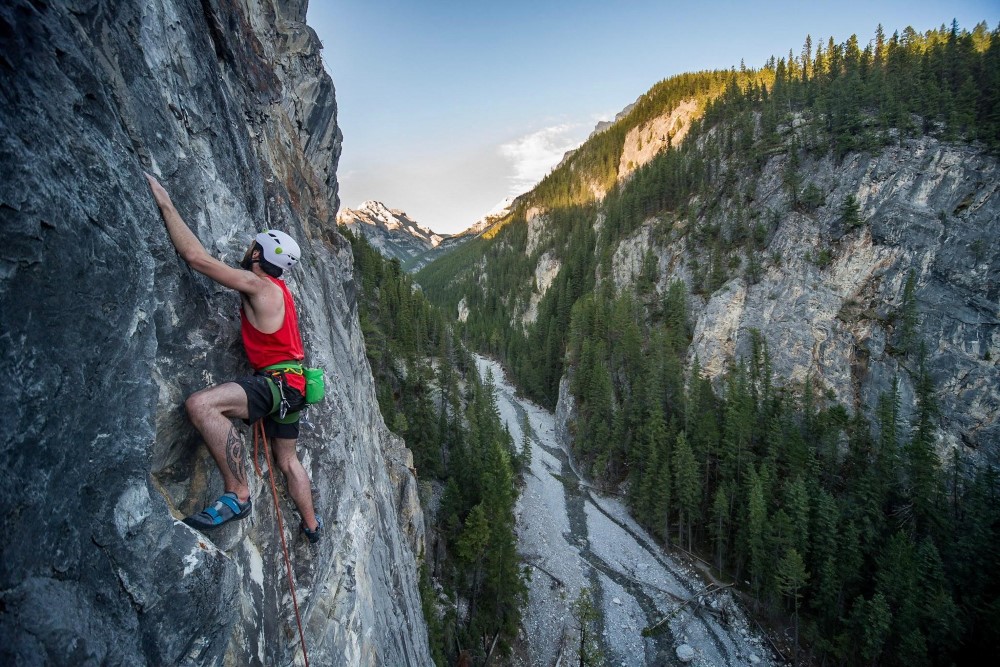
Downturn
Downturn is the radical curved shape of a shoe that, given the right color, makes it resemble a pre-send banana. Despite the amount of sending bananas you eat though, it’s unlikely you’ll be growing chimp-like feet anytime soon that allow you to grab holds when the climbing gets steep. That’s where the downturn of the shoe comes into play, forcing your foot into a curved position that allows you to hook holds when you need to keep your lower half on the wall. As you can imagine, the tension your foot is under while the shoe forces it into such a position doesn’t exactly give them the feel of your favourite loafers, especially when you stand up and weight your foot. However, shoes that fall under this category, such as the La Sportiva Skwama, or the Booster S from Scarpa, are better suited for steep to straight up overhanging routes, where you’re not going to be weighing your feet so much as keeping your body from flailing around wildly, like a rock climbing orangutan.
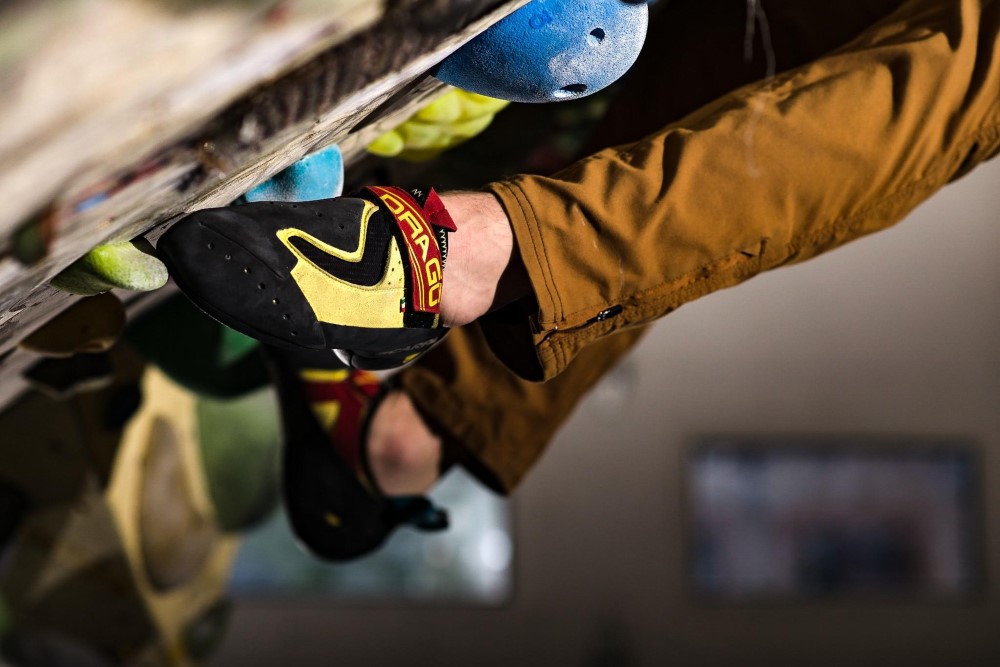
Between the two extremes of dead flat, and absolutely downturned are varying degrees of profile that allow some shoes to be better suited as an all arounder. A good example would be the Scarpa Vapor V with a slight downturn for steep climbing performance, but not so radical as to render it useless or horrendously painful when the climb becomes off vertical. These are often a great transition from your first pair of shoes, as they will typically make for a decent “quiver of one” after having totally blown out your flat “beginner” shoes. Though they may be slightly less comfy than the shoes you learned in, the change isn’t quite so drastic as some of the more aggressive shoes.
Symmetrical vs. Asymmetrical
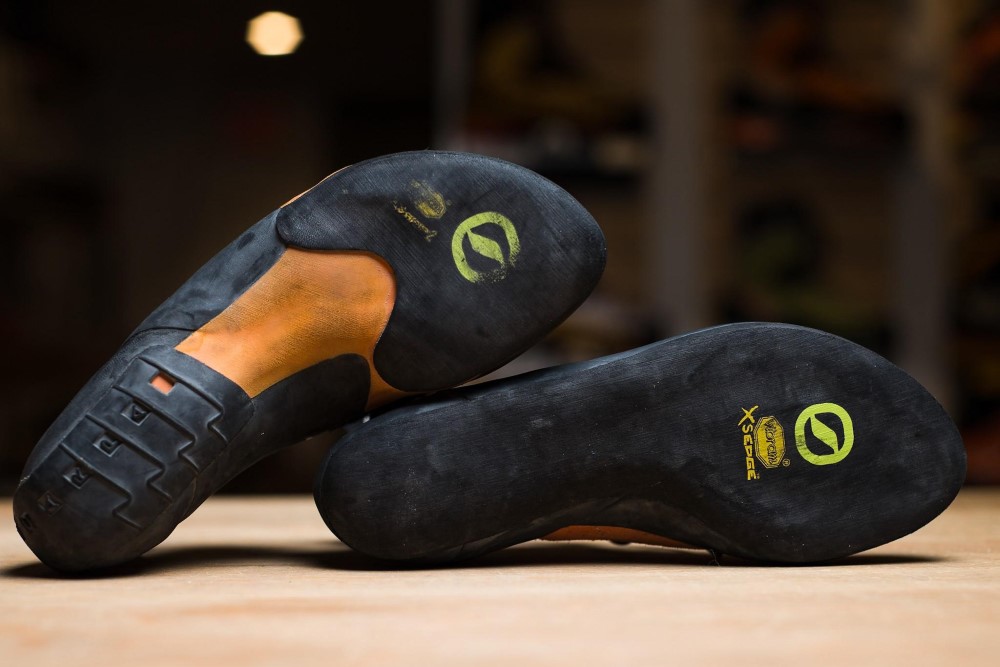
Stick your foot out and try to press an imaginary button on the wall with your toes as hard as you can. You’ll probably notice you’ve flexed your foot and scrunched all of your toes together to a point. Also, take note of what you’re pressing that imaginary button with; your big toe. An asymmetrical shoe has a visible bend in it, along the sole of the shoe, from the big toe to the heel. Much like a downturned shoe, the shape is forcing your foot into this more powerful position, allowing you to focus more weight through the big toe (it’s no coincidence that this is the point of the shoe). Again, this comes at the cost of comfort, so choosing the shape is dependant on the use. With a symmetrical shoe being better suited for longer routes and shoes with high asymmetry, such as a Miura, being more appropriate for high performance climbs where precision takes precedence over comfort.
Midsole: Stiff or Soft?
Somewhere between the tacky rubber placed against the rock and your sweaty foot is the midsole of the shoe (if it has one). This piece of material that’s been sandwiched between the shoe’s sole and upper will determine how stiff the shoe is, depending on its thickness, material, and where it's been placed (some may only have midsoles surrounding the very edge, where others will cover the entire forefoot). The question is: “Why would I want a stiff/soft shoe?”. But this again will fall under which application you plan on using it.
Stiff
Stiffer shoes offer much more support for longer routes where your feet and calves would suffer from fatigue if they were placed in a much softer shoe. This is because they allow you to put more of your weight through your shoe rather than relying on the flexing of those muscles for support (say goodbye to those calf gains. Cancel your waxing appointment. Buy Climbing pants). This also means shoes like these are particularly great for edging on vertical terrain as well, where most of your weight is going to be on your feet.
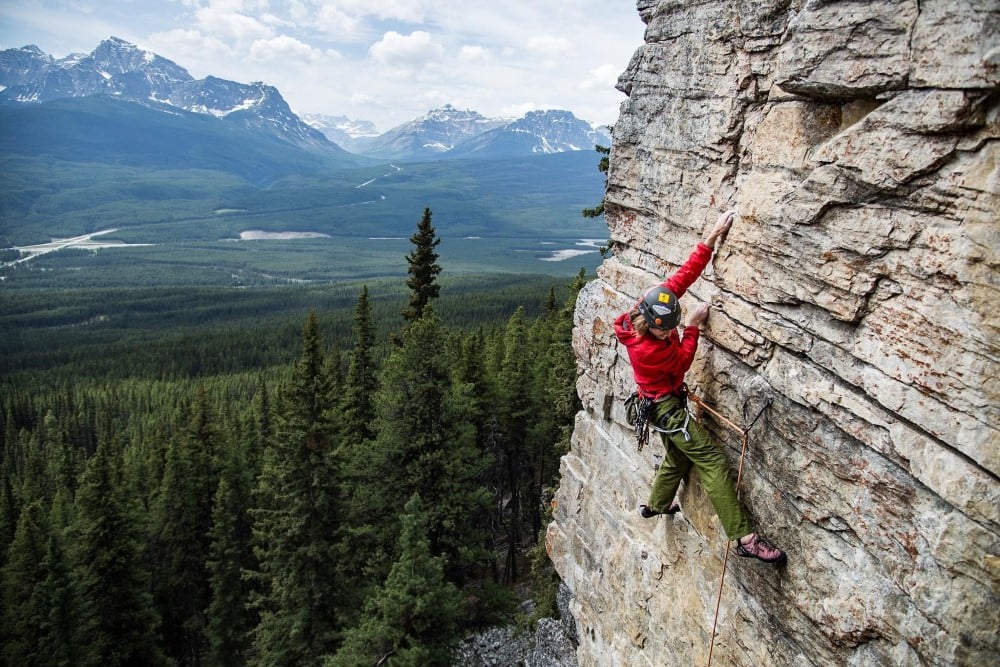
Soft
Soft shoes have much of the same benefits as downturned shoes, which is normally why bouldering or high-performance sport shoes feature both a downturned shape and a very soft midsole, or no midsole at all in some cases. This allows you to flex your toes to hook or “grab” holds on overhanging terrain, bringing you one step further to having chimp-like abilities (or gorilla if bouldering is your thing). Softer midsoles also give the shoe more “sensitivity”, meaning you’re able to better feel those credit card edges or granite nubbins that seem so desperate. This, of course, won’t make you stick to them any better, but it will make you more aware of your footing.
Fitting The Shoe
So now that you have an idea of what might best suit your style of climbing (still don’t care about your buddies Solutions) you’ve got the equally daunting task of getting a proper fit. This is going to be a combination of finding a shoe that matches the volume of your foot, as well as choosing the appropriate size. I’m sure you’ve heard it all. That Scarpa’s fit wider so you’re going to need Sportiva’s, and that you should get them 3 sizes too small or you won’t be able to climb well but bear with me.
Something to keep in mind is that climbing shoes are built on something called a last, which for simplicity sake, is essentially a fake foot that the shoe is built around to give it its characteristics. Manufacturers have many different lasts suited to different shapes and sizes of feet, so each manufacturer has something to offer everyone. It’s just a matter of finding which shoe best fits the shape of your foot. If you already know you have a particularly wide foot, Morton's toe, or so on, give the guys at the climbing shop a heads up as they are well educated in what they carry and should have a good idea of what shoes are going to work for your foot shape.
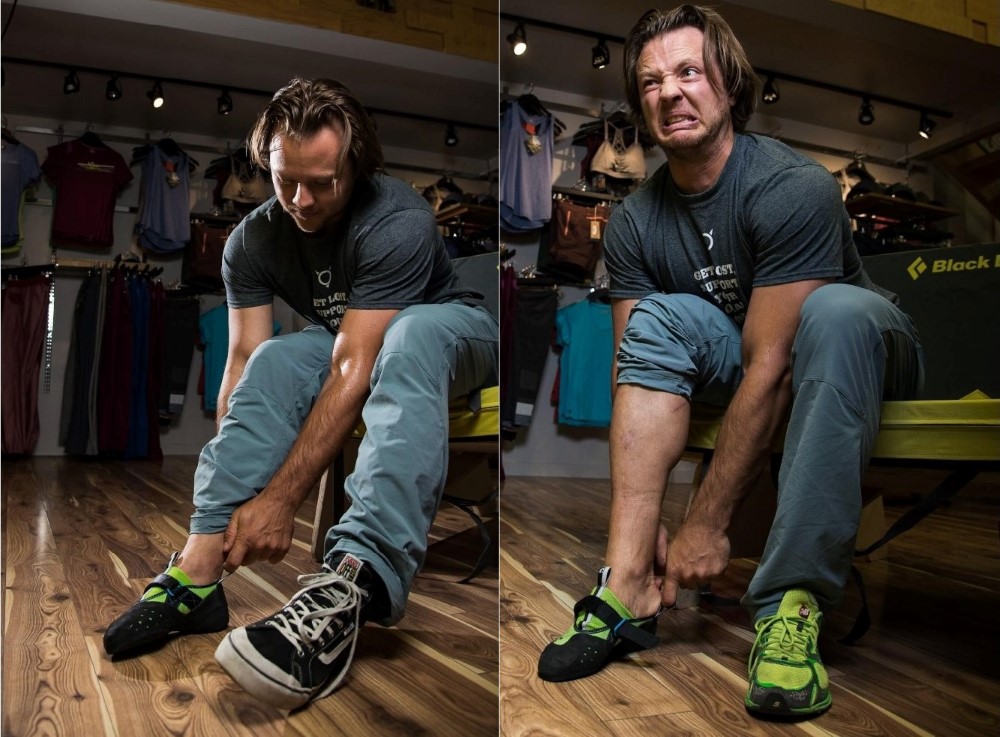
Choosing your size is a little more involved, but still fairly straightforward. A few key points to keep in mind are going to be how soft the shoe is, how you intend to use them (obviously don’t a get toe-curling shoes for multi-pitch), and probably the most important factor; what the upper is made of, as this will determine how much the shoe is going to stretch. It’s true that Adam Ondra sizes his shoes down 5 sizes and it’s hard to argue with the best sport climber on the planet, but you really don’t have to crush your feet to climb better (when you’re climbing 5.15 you can do what you like). On the flip side, if you wear a shoe that’s too roomy, it’s going to move around on your foot allowing it to roll off the hold. A good starting point is about one euro size down from your foot's size (most brands). This should give you a fit that is snug and secure, making sure there’s no dead space in the shoe, but not so painful you feel the need to walk on your heels. If this is your first pair of shoes, keep in mind that this isn’t going to be comfortable at first, but your feet do get accustomed to it, and the shoes will break in.
For softer shoes, like the Skwama from La Sportiva, you’re going to want them to be a little tighter than normal since they rely heavily on your foots tension to keep the shoe rigid for edging, whereas a stiffer shoe can be worn a little more comfy since the midsole is stiff enough to support the load.
Another thing to keep in mind is the upper’s material. Going with a fully synthetic shoe like a Black Diamond Momentum ensures a true out-of-the-box fit since they generally won’t stretch much, if at all. This ensures a truer fit from the get-go but, the shoe won’t “break in” as much. An unlined leather shoe will, however, stretch and form to the shape of your foot, giving it a more custom fit. This comes at the cost of the shoe stretching up to a full size though, so fitting these shoes can be less comfortable off the get-go, but the reward is a more tailored shoe. So if it feels the way you want it to feel, go down a size. In between these two are lined leather shoes that make up the middle ground. You can expect these to stretch a half size.
At the end of the day, there will never be a perfect do everything shoe. This would probably explain my overflowing bin of climbing shoes stashed away in my closet with wickedly downturned shoes, three sizes below my Vans, for those days I'm feeling steep sport, and shoes so comfy I could take a hike in them if I weren’t concerned about wearing them out. Sadly, it may not be within everyone’s budget to own so many shoes, and I know there is no do everything shoe, so in the end, you must ask “ Where do I spend most of my time climbing ?”.
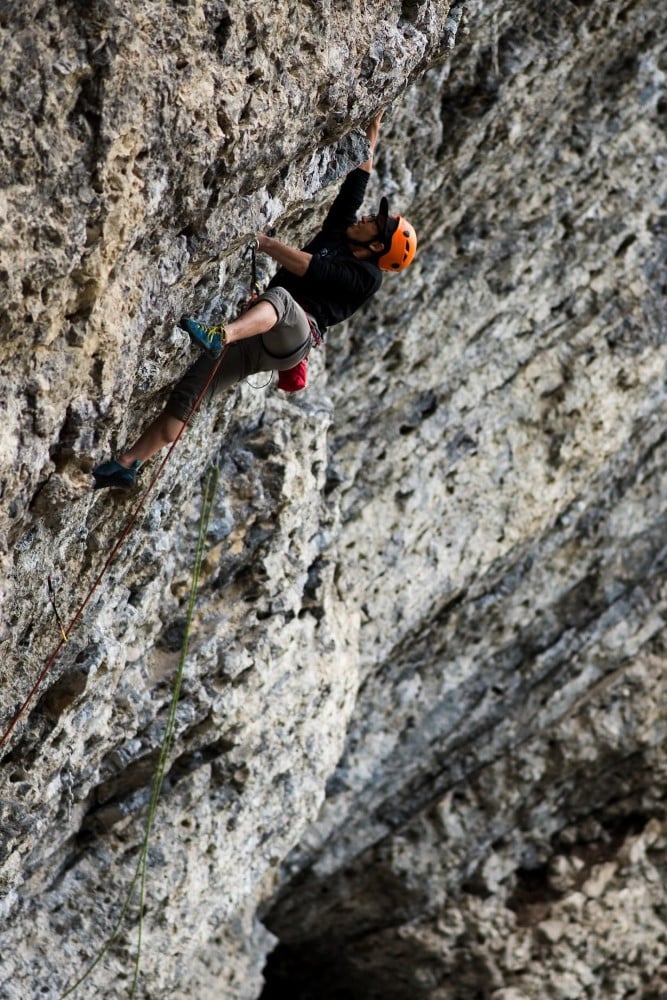
 |
Feel free to leave a question or a comment, it is always a pleasure to read you! |

Comments
Be the first to comment...